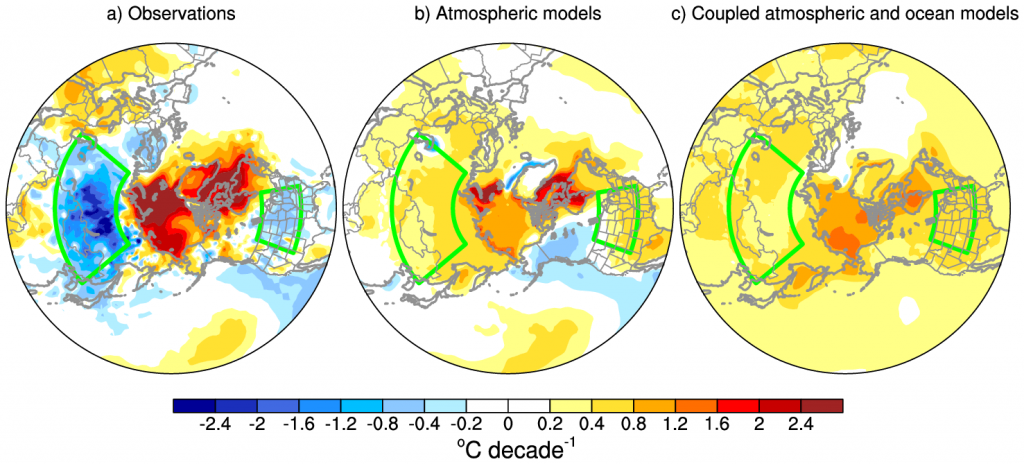31 May 2016
Arctic sea ice loss likely not a factor in recent Northern Hemisphere cold winters, study finds
Posted by Lauren Lipuma
By Karin Vergoth
Arctic sea ice loss is a major factor behind the warming Arctic, but melting sea ice is probably not behind recent cold winters in parts of Europe, Asia, and the United States, according to new research published in Geophysical Research Letters, a journal of the American Geophysical Union.

A car at the Massachusetts-New Hampshire border during the January 2015 nor’easter. New research shows melting Arctic sea ice is probably not behind recent cold winters in parts of Europe, Asia, and the United States.
Credit: Medeis via Wikimedia Commons.
Recent accelerated warming of the Arctic has coincided with several unusually cold winters in the Northern Hemisphere’s mid-latitude continents. This winter temperature pattern has been referred to as “Warm Arctic, Cold Continents,” and some scientists have proposed that Arctic change is the driver.
“Our findings indicate that recent Northern Hemisphere cold winters were the result of naturally occurring climate variations, and not due to remote effects of Arctic sea ice loss,” said Lantao Sun, a researcher in the NOAA Earth System Research Laboratory at the Cooperative Institute for Research in Environmental Sciences (CIRES) in Boulder, Colorado and the study’s lead author. Sun, along with CIRES and NOAA colleagues, examined the influence of Arctic sea ice loss on the Arctic atmosphere and temperature patterns in the lower latitudes.
According to some scientists, Arctic sea ice loss and the resulting warming induce atmospheric patterns that allow much colder air to invade the mid-latitudes, creating “Warm Arctic, Cold Continents.” In this new study, the researchers use multiple climate models to test this hypothesis, and examine whether sea ice loss is the ultimate driver. The results indicate that sea ice loss is indeed warming the Arctic, but neither sea ice loss nor human influence overall caused recent cold continental temperatures. “It’s just by chance and not because of Arctic sea ice loss or human-caused factors that ‘Cold Continents’ has happened more often in recent years,” said Judith Perlwitz, a CIRES scientist at NOAA and a co-author on the paper.

The observed winter temperature trend since 1990-91, “Warm Arctic, Cold Continents,” consists of cold winter temperatures over central/east Asia and central North America (outlined in green), encircling a strong Arctic warming. b and c) A majority of model runs covering the same time period show a “Warm Arctic, Warm Continents” pattern.
Credit: Lantao Sun/CIRES/NOAA.
The researchers find that the recent cooling trend over mid-latitude continents can be explained instead by naturally occurring climate patterns. “For example, the winter cooling trends over Eurasia are accompanied by a strengthening of the Siberian High, which brings more cold air from the Arctic into central and eastern Asia,” Perlwitz said. A similar regional circulation causes North American cold temperatures. “These well-known circulation patterns are the major drivers of the wintertime temperature variability in northern mid-latitudes and recent Arctic sea ice loss does not substantially affect them.”
The researchers do find that Arctic sea ice loss affects mid-latitude weather, but in other ways. Arctic sea ice loss warms the usually frigid air masses that occasionally invade midlatitudes, reducing daily temperature variability in those regions and making cold outbreaks less common. “Our results suggest that the southward moving Arctic air masses are simply less cold, on average,” said Martin Hoerling, a NOAA scientist and co-author on the paper.
The researchers conclude that the true pattern of temperature change due to human influence in the Northern Hemisphere since 1990 is best characterized as “Warm Arctic, Warm Continents.” Most of the model runs show both regions warming, Sun said, suggesting that extremely cold winters over Northern Hemisphere continents are becoming increasingly unlikely as the climate continues to warm.
—Karin Vergoth is a science writer at CIRES, which is a partnership of NOAA and CU-Boulder. This post originally appeared as a news release on the CIRES website.










 GeoSpace is a blog on Earth and space science, managed by AGU’s Public Information staff. The blog features posts by AGU writers and guest contributors on all sorts of relevant science topics, but with a focus on new research and geo and space sciences-related stories that are currently in the news.
GeoSpace is a blog on Earth and space science, managed by AGU’s Public Information staff. The blog features posts by AGU writers and guest contributors on all sorts of relevant science topics, but with a focus on new research and geo and space sciences-related stories that are currently in the news.